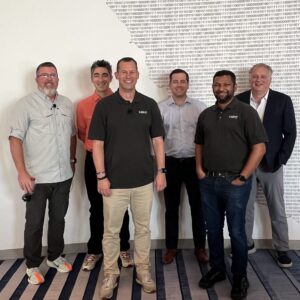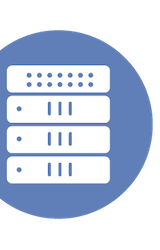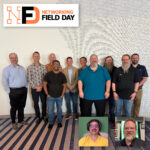|
|
 Jerrod Howard, Marty Ma, Dobias Van Ingen, Adam Fuoss, Matthew George and James Robertson presented for HPE Aruba Networking at Networking Field Day 38 |
This Presentation date is July 10, 2025 at 10:30-12:30.
Presenters: Adam Fuoss, Dobias Van Ingen, James Robertson, Jerrod Howard, Justin Sergi, Marty Ma, Mathew George, Onno Harms
Follow on Twitter using the following hashtags or usernames: #NFD38
HPE Aruba Networking Executive Overview with James Robertson
Watch on YouTube
Watch on Vimeo
James Robertson, VP & GM, kicked off the session by outlining HPE Aruba Networking’s focus on two significant industry shifts: AI for networking (AI-powered NetOps) and networking for AI. The former aims to enhance network efficiency and effectiveness using AI, while the latter is positioned as a new foundational infrastructure for AI workloads in data centers. He emphasized the critical role of data collection as the foundation for AI operations, explaining that a comprehensive data lake, fed by extensive telemetry from across the network, is essential for gaining true visibility and extracting actionable insights. This data-driven approach underpins their strategy to deliver security-first, AI-powered networking, leveraging machine learning to identify anomalies that humans might miss and to create an infrastructure that drives optimal user experiences.
Robertson highlighted three key differentiators for the Aruba portfolio. First, their full-stack integration means that all wired, wireless, and WAN components, whether on campus or in the cloud, are managed through Aruba Central, providing a single pane of glass for comprehensive visibility. Second, HPE Aruba Networking has expanded its deployment options beyond cloud-managed solutions, now supporting on-premise, near-premise, and sovereign (air-gapped) environments to meet diverse organizational needs. Third, they address the challenge of broad observability across the entire IT estate through the integration of OpsRamp, an HPE-acquired company. OpsRamp provides a unified view across security, networking, virtualized platforms, and storage, enriching the telemetry data fed into their AI models for deeper insights.
He further elaborated on HPE Aruba Networking’s AI journey, distinguishing between traditional AI (anomaly detection based on historical data), generative AI (leveraging larger datasets for decision-making and understanding), and the recently announced Agent AI. Agent AI, the latest advancement, focuses on reasoning, allowing the system to combine accumulated knowledge with real-time infrastructure data to proactively identify issues and suggest actions, mimicking human problem-solving. This entire AI framework is underpinned by Aruba Central, which fundamentally aims to connect and protect all infrastructure components, utilizing telemetry for security decisions and automating operations to provide network teams with real-time insights and control.
Personnel: James Robertson
Simplify Network Management with HPE Aruba Networking Central
Watch on YouTube
Watch on Vimeo
Learn about AI, deep platform intelligence, self-optimizing, observability, troubleshooting and more. Dobias van Ingen, CTO and VP for System Engineers at HPE Aruba Networking, detailed the evolution of Aruba Central, emphasizing its role in addressing common enterprise challenges like domain fragmentation, policy inconsistency, experience gaps, high operational costs, data sovereignty, and vendor lock-in. Their journey began in 2017 by unifying wireless solutions under a single operating system, followed by unifying wired networks in 2019 to provide consistent role-based policies and application visibility. The latest step involved integrating fabrics with SD-Branch/SD-WAN applications (EVPN, VXLAN) and, crucially, developing a common operational model that supports various consumption models, including public cloud, managed services, Network as a Service (NaaS), and on-premise deployment of the same cloud software.
The presentation highlighted Aruba Central’s unique unified configuration model, allowing users to manage network infrastructure through UI, CLI, or API, with changes reflected consistently across all interfaces. This is powered by a central Yang model, ensuring that configurations for roles, profiles, and services are seamlessly applied across access points, gateways, and switches, regardless of their specific device persona. A key demonstration showcased how a single authentication server profile could be configured once and then assigned to various device functions and scopes (e.g., global, regional, device group), significantly simplifying management and reducing potential errors. Furthermore, the unified architecture ensures that all feature sets are available across on-premise and cloud deployments, with minor exceptions for some AI functionalities.
Dobias also delved into user experience insights (UXI), which leverage sensors (physical or software agents) and network telemetry to provide comprehensive data on client and application performance. This includes detailed path analysis, identifying latency across hops and even into tunnels, offering crucial troubleshooting data that goes beyond traditional trace routes. The discussion then transitioned to Agent AI, the evolution beyond traditional and generative AI. Agent AI focuses on reasoning and autonomous action, allowing the system to combine vast knowledge bases with real-time network data to proactively identify issues and suggest or even schedule automated remediations (e.g., disabling an 802.11r amendment for problematic clients). This intelligence is surfaced through a “Network Copilot” interface, enabling natural language interaction for troubleshooting and automated problem-solving, along with multi-vendor operability (e.g., monitoring Cisco switches within Aruba Central) to ease transitions and prevent vendor lock-in.
Personnel: Dobias Van Ingen
Modernize Virtualization Stack with HPE Aruba Networking CX Switches
Watch on YouTube
Watch on Vimeo
Marty Ma, Director of Product Management for HPE Aruba Networking’s CX switching strategy, presented on modernizing the virtualization stack with HPE Aruba Networking CX Switches. He introduced new products and recent integrations that unify HPE’s offerings. The CX switch portfolio, established in late 2016, now spans from 1 GBe to 400 GBe, all operating on a common software platform and managed by Aruba Central. This broad portfolio supports campus, branch, remote, access, aggregation, and core environments, as well as high-density data center deployments. A key innovation in late 2021 was the introduction of the first smart switch featuring a DPU (Data Processing Unit) from AMD Pensando, designed to bring services closer to the workload at the top of the rack. This was followed by the CX 10040, focused on 100 GBe server connectivity, both offering stateful Layer 4-7 services, East-West firewall inspection, and high-resolution telemetry.
Ma then linked this to the broader HPE GreenLake strategy, emphasizing the HPE Private Cloud Solution and HPE Private AI offerings, all orchestrated by HPE Morpheus software. He specifically highlighted Morpheus VM Essential, a next-generation virtualization management solution that unifies disparate hypervisor environments (like existing VMware ESXi clusters and KVM-based environments), all managed through a single pane of glass: HVM Manager. This aims to provide a more cost-effective alternative for customers concerned about rising hypervisor licensing costs. The overall HPE strategy positions them as a unique IT vendor capable of delivering a full hybrid cloud stack, with Morpheus for management and OpsRamp for comprehensive visibility across all environments.
The presentation underscored how the CX smart switching portfolio integrates with this virtualization strategy. Customers can leverage plugins to connect DPU-equipped switches into their hypervisor environments, enabling macro and micro-segmentation and advanced network services directly at the first-hop switch, even for bare-metal servers. This approach aims to simplify virtual networking across different hypervisors by offloading network policy enforcement to the hardware. The ongoing trend of increasing network speeds, driven by AI workloads, further validates HPE’s decision to integrate DPUs into switches, making the conversation about DPU placement more relevant than ever. The entire solution is designed to simplify complex end-to-end problems by providing a holistic view from compute and storage to networking, orchestrated and managed centrally.
Personnel: Marty Ma
Expanding Access Points as a Platform Capabilities
Watch on YouTube
Watch on Vimeo
This presentation shows the features & benefits of Wi-Fi 7 APs including flex-radios, dynamic antennas, IoT, containers and more. Jerrod Howard, a hardware product manager at Aruba, introduced the concept of the Access Point (AP) as a platform, highlighting how HPE Aruba Networking is building its Wi-Fi 7 portfolio with increasingly flexible radios and complex internal technologies. He explained the drive towards more adaptable radios that can serve different regulatory regions without restriction, allowing deployment as dual band APs to maximize radio utilization. A key innovation is the development of dynamic antennas, which allow a single AP SKU to function as both an omnidirectional and directional access point, configurable via software. This flexibility is particularly beneficial for environments with varying coverage needs, such as warehouses with sloped ceilings or high-density conference rooms that transition from empty to packed.
Justin Sergi, Product Manager covering IoT, further expanded on the “AP as a platform” concept by discussing HPE Aruba Networking’s IoT and containerization strategy. The goal is to consolidate parallel IoT overlays, allowing the AP to serve as a unified IoT gateway with onboard dual IoT radios and extensible USB ports. This evolution is supported by an “App Store” within Aruba Central, enabling customers to deploy various IoT integrations (e.g., electronic shelf labels, asset tracking, access control) as container-based workloads. This decoupling of IoT integrations from the AP’s operating system through a cloud-native microservices architecture significantly accelerates development and deployment. The developer portal further empowers partners to self-publish new applications, managing their own versioning and ensuring security within a container sandbox with limited resource access.
The discussion also touched upon the Smart Antenna Module (SAM), a sensor embedded in outdoor Wi-Fi 6E and Wi-Fi 7 APs. SAM identifies the antenna, carries RPE data (gain, beamwidth), and reports heading and downtilt, providing critical telemetry about the AP’s physical orientation and performance. This data, combined with advancements in software, will become increasingly crucial for optimizing Wi-Fi 7 deployments. The overall strategy underscores HPE Aruba Networking’s commitment to simplifying network management and extending the capabilities of the access point, turning it into a versatile edge device capable of supporting diverse applications, IoT integrations, and advanced AI functionalities, all while offering flexibility in deployment and reducing operational complexity.
Personnel: Jerrod Howard, Justin Sergi
Edge to Cloud Security: Harnessing NAC, SASE and ZTNA
Watch on YouTube
Watch on Vimeo
See new Central cloud native NAC; SASE with SSE, SD-WAN & NAC; new ZTNA natively in SD-WAN Gateways. Adam Fuoss, VP of Product for EdgeConnect SD-WAN, outlined HPE Aruba Networking’s integrated SASE portfolio, comprising SSE (Security Service Edge) for cloud-based security focused on ZTNA (Zero Trust Network Access), EdgeConnect SD-WAN for connecting diverse locations, and ClearPass/NAC (Network Access Control). He highlighted the challenge of traditional ZTNA connectors, which often rely on virtual machines in data centers, leading to inefficient traffic hair-pinning when applications reside in branches. To address this, HPE Aruba Networking has integrated the SSE connector as a container directly into the EdgeConnect SD-WAN appliance, allowing users to connect to cloud security services and then directly to branch applications without backhauling traffic, significantly improving efficiency for distributed applications and remote contractors.
Mathew George, a Technical Marketing Engineer, then provided an overview of Central NAC, HPE Aruba Networking’s cloud-native NAC offering. This solution aims to simplify user and device connectivity by leveraging cloud-based identity sources like Google Workspace, Microsoft Entra, and Okta for authentication and authorization. Central NAC uses Client Insights for advanced device profiling, combining fingerprints with traffic flow information and AI/ML models for accurate classification. It integrates with third-party systems like MDM and EDR solutions to pull compliance attributes, which are then used in NAC policies. Central NAC also supports certificate-based authentication (including “Bring Your Own Certificate” with external PKI), MPSK (Multi-Pre-Shared Key) for user-based or admin-based device authentication, and various guest workflows. A key feature demonstrated was the real-time re-authentication and policy enforcement based on changes in the Identity Provider (IdP), showcasing true Zero Trust in action.
The presentation underscored HPE Aruba Networking’s commitment to a unified Zero Trust posture across their entire portfolio. The vision is for a single policy engine to enforce security from Wi-Fi and IoT devices all the way through switches, access points, gateways, and the SSE cloud. This includes multi-vendor support, allowing for VLAN enforcement on third-party switches like Cisco. While Central NAC streamlines simpler use cases, ClearPass continues to address more complex, on-premise requirements. The overall message emphasized leveraging telemetry-based networking and AI-driven insights to enhance security, improve endpoint experiences, and provide engineers with the necessary data to maintain optimal network performance, ultimately enabling a truly integrated security and networking approach from edge to cloud.
Personnel: Adam Fuoss, Mathew George








